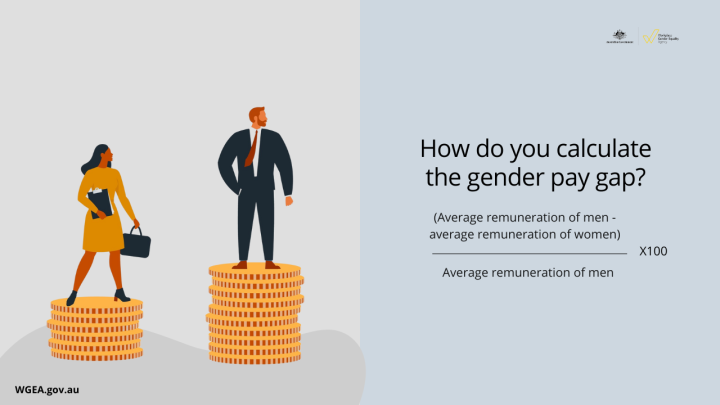The gender pay gap is a simple calculation that always stays the same. It is the difference between the average pay for men and women, expressed as a percentage of men’s pay.
You may see different figures for the gender pay gap. The calculation doesn’t change. What changes is how people define ‘pay’ or ‘remuneration’.
Pay can be defined as base salary or total pay, which includes super and bonuses. It could be what someone earns in an hour, a week or a whole year. It can be full-time workers only or include part-time and casual workers too.
Regardless of what measure of pay you use, there is always a gender pay gap in favour of men in Australia.
Why does WGEA have two different gender pay gap figures on the website?
We’re often asked why WGEA has two different gender pay gap figures on its website. One is the national gender pay gap. The other is the WGEA gender pay gap.
The gender pay gaps are different because of the way ‘pay’ is measured in the datasets used to calculate these numbers.
WGEA uses:
- the annual WGEA Employer Census data to calculate the WGEA gender pay gap
- the Australian Bureau of Statistics (ABS) Survey of Average Weekly Earnings to calculate the national gender pay gap.
There are many different datasets that can be used to calculate a gender pay gap.
It doesn’t matter what data you use; every dataset shows a gender pay gap in favour of men.
The Australian Bureau of Statistics provides a helpful guide to all the different approaches to measuring a gender pay gap in Australia. You can also find out more about what the ABS data includes and excludes when it defines ‘pay’ below.
How is the WGEA gender pay gap calculated? Explore the details in our interactive.
How will WGEA calculate employer gender pay gaps?
WGEA will publicly report employer gender pay gaps for companies with 100 or more employees from early 2024, starting with private sector employers.
For the first release of private sector employer gender pay gaps in early 2024, WGEA will publish employer gender pay gaps by median as well as the gender composition and average remuneration per pay quartile.
In the second release of gender pay gaps, after CEO, head of business and casual manager remuneration data can be included in the dataset – WGEA will publish employer gender pay gaps by average as well as median.
WGEA will use the same formula to calculate employer gender pay gaps as we use to calculate gender pay gaps at a national and industry level.
What do you mean by average or median?
The average gender pay gap (sometimes referred to as the mean gender pay gap) is calculated by adding up the wages of all employees and dividing that number by the number of employees. If a business has five employees and three are paid $60,000, one is paid $90,000 and one is paid $100,000. The average pay at that business is $74,000.
As an equation, that is ($60,000 + $60,000 + $60,000 + $90,000 + $100,000)/5 = $74,000.
The median is the number that falls into the middle when everyone’s wages are lined up from smallest to largest. If we use the same example above, the median wage in the business would be $60,000.
In a perfectly symmetrical distribution, the average and the median are the same. But pay isn’t symmetrical in any business. Just like with house prices, the average can be skewed by a big salary at the top end of the scale.
From the 2023-2024 reporting year, employers must report CEO, head of business and casual manager remuneration to WGEA. We know that CEO remuneration will be much larger than other employees and that almost 80% of CEOs in the WGEA dataset are men.
For the first year of gender pay gap reporting, employers will not have reported on CEO remuneration. As noted above, CEO salaries may have a significant impact on average gender pay gaps.
To ensure gender pay gaps are accurate and comparable over time, WGEA will only publish median gender pay gaps in 2024. From the following year, WGEA will publish both the average and the median.
How does WGEA calculate the ABS national gender pay gap?
WGEA calculates the national gender pay gap using data from the Australian Bureau of Statistics (ABS) Survey of Average Weekly Earnings released in February and August every year.
This data comes from a sample of employers selected from the Australian Business Register, with a slightly different sample taken each time.
This dataset:
- estimates full-time weekly base salary employees in the public and private sector
- excludes overtime, pay that is salary sacrificed, and superannuation
- excludes junior and part-time employees.
Excluding these datapoints from the gender pay gap calculation results in a lower gender pay gap.
What about non-binary employees?
The gender pay gap calculation does not yet include data about non-binary employees.
In 2021, employers could voluntarily report employee gender as non-binary for the first time. Employees identifying as non-binary accounted for 0.1% of the workforce gender composition in WGEA’s dataset.
Given the small sample size, employees identifying as non-binary can not be statistically analysed for the purposes of the gender pay gap. WGEA will continue to reassess this should the sample size increase.
Recommendation 7.2 of the WGEA Review called for WGEA to collect data on people who identify as non-binary. .I It is vital this is done it in a way that ensures people who identify as non-binary feel safe to disclose this information at work, and have confidence that their privacy will be preserved.
WGEA is working in partnership with specialist organisations, the community sector, unions, and industry groups to develop an approach to support employers to collect this information that is safe and respectful to people who identify as non-binary.


